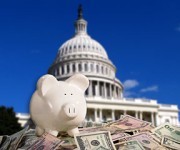I can certainly understand why people are unhappy with the weakening of Waxman-Markey. Heck, I lowered the grade for it to B or B-.
But I wasn’t grading on a curve. The bill remains a stunning legislative achievement that (if enacted) would require the United States to eliminate virtually all greenhouse gas emissions in four decades — no mean feat, even for those of us who know that is eminently doable (and climatically crucial)!
Indeed, when was the last time the nation’s political system enacted a major economy-wide air-pollutant regulatory system? [Hint: It was a long time ago and a key reason it passed is a cap-and-trade system that gave away virtually all of the pollution allowances to industry — interesting NYT piece today on the politics of emissions regulations then and now.]
On the other hand, if Waxman-Markey fails to get out of committee or fails to make it through both houses of Congress over the next 12 months or so, don’t expect any US climate action for a long time — the political mavens will not take failure as a sign to pursue a stronger bill. And failure would mean the international negotiation process would be dead. Equally important, why would China agree to a target if we don’t?
If the hardcore enviros want to attack the bill (as opposed to some of its provisions), to undermine support for what Al Gore called “One of the most important pieces of legislation ever introduced in the Congress … has the moral significance” of 1960s civil rights legislation and Marshall Plan, well, it’s a free country, as they say.
And I’m free to point out the absurd rhetoric and factually flawed arguments. Before I get to the myths about the European Trading System that Greenpeace is peddling in its press release Thursday, let me start with their indefensibe and over-the-top first line:
A piece of legislation that started out as a real opportunity for the US to combat climate change has been co-opted by special interests and now threatens to do more harm than good.
Uhh, no it does not. Maybe it threatens to not do as much good as it could as fast as it might, but, frankly, that was true of the first draft. Or any politically feasible energy and climate bill.
To repeat, whatever people imagine that this bill “threatens” to do, what it actually does is enact into law a sweeping clean energy revolution that puts the nation on a path to virtually eliminate global warming pollution from the entire economy in four decades.
PEDDLING MYTHS ABOUT THE EUROPEAN EMISSIONS TRADING SCHEME
Beyond the overheated rhetoric is the repetition by Greenpeace of a now too-common myth that needs addressing:
According to reports, the bill might actually end up giving as much as 55 percent of the permits away for free. The EU’s Emissions Trading Scheme originally gave away so many permits that pollution permits were trading for as little as 1 euro cent, providing no incentive for polluting industries to clean up their act. Now the fossil fuels industries –- who have spent some $45 million lobbying against the bill -– are succeeding in convincing House Democrats to make the same mistake.
Not quite.
Greenpeace — and many other people, to judge by the e-mails and comments I get — are conflating two completely different issues.
The EU’s emissions trading scheme (ETS) had too many total permits. That was why the price crashed, not because those permits were given away for free. If the EU had auctioned all the tons, the price still would have crashed as soon as everybody realized there were too many in the market.
What people forget about ETS Phase one, from 2005 to 2007, is that the hard emissions caps the Europeans had agreed to under the Kyoto protocol didn’t kick in until 2008. Phase one was thus a wild and unique experiment — a trading system without a true, binding cap. I never thought it would seriously motivate much action by industry or be a big success, but in fact, it certainly wasn’t a total failure, especially given that the Europeans had never done anything like this before.
A poorly headlined piece in Reuters, “U.S. cap and trade plans risk European mistakes” almost gets the story right but ends up spreading confusion:
The European Union scheme, launched in 2005, has struggled to shake off two early mistakes: handing out too many permits which removed the requirement to buy them, and giving them to power plants for free.
Analysts say utilities pass on the price of carbon permits to consumers regardless, making billions of euros (dollars) in windfall profits across the sector as a result.
And because there were initially too many permits the EU carbon price crashed to zero two years ago, relegating the first trading phase of the scheme from 2005-07 to an experiment.
Note to Reuters: It always was an experiment. In Phase 1, the EU was not under legally binding emissions reduction targets.
Why did the EU have too many allowances? Well, unlike the United States, where we have a single Energy Information Administration that keeps close tabs on coal, oil, and natural gas supply and demand as well as total greenhouse gas emissions, the EU is still a relatively dysfunctional collection of very distinct countries. It simply is a lot harder for them to estimate accurately total emissions, particularly since they had never done it before and never had a trading system before. As one 2007 analysis put it:
… at the outset, the European Commission had no reliable information about companies’ emissions, and was therefore obliged to use figures provided by installations themselves. In the spring of 2006, it became evident that in fact actual emissions were below the initial allowances. This led to some of the most volatile days in the market as prices fell close to zero.
I would note that an analysis by MIT’s Joint Program on the Science and Policy of Global Change (among others) had predicted a price crash back in Ocotober 2005, concluding that the ETS’s market clearing price should be “about 0.6 to 0.9 euros/tCO2 (~2 to 3 $/tC) for the 2005-2007 period in a base run of our model in line with many observers’ expectations who saw the cuts required under the system as very mild.” I think is quite fair to say that the Europeans screwed up the Phase 1 experiment, especially how it was perceived elsewhere — but given how many people foresaw both what was going to happen and the reason why it happened, I just don’t think you can point to Phase 1 as proof that a cap-and-trade system is inherently flawed.
Why did the EU give away such a high fraction of the allowances? In part because they became sold on the benefits of cap-and-trade in the first place from the incredible success of the acid rain program in this country, which achieved faster and deeper emissions reductions at a far lower cost than everybody had predicted. And the EPA gave away 97% of the permits to industry for free.
What about the windfall to industry and the possible disincentive to industries to clean up their act of they are are given free permits? Waxman-Markey learned from European mistakes, as Reuters explains:
So far the U.S. plans appear aware of the risks — allocating free permits for example to the steel sector according to average emissions — meaning if you pollute less you’ll still get the same number of permits, and a surplus to sell as a reward for being clean.
The ruling Democrat plans would also avoid some of the risks of EU-style windfall profits, because in the electricity sector the permits would go to local distribution companies regulated by states which could limit how far utilities pass on costs.
“The difference between this and the EU is that they go to regulated entities that have to pass the value directly to consumers,” said Tony Kreindler, spokesman for Environmental Defense Fund.
Let me also return to the must-read (or must-watch) E&E TV interview of Richard Morgan, a DC commissioner and leader of the National Association of Regulatory Utility Commissioners’ Task Force on Climate:
Monica Trauzzi: Looking at Europe as an example, too many credits were handed out there which ended up creating windfall profits for utilities. So how does Congress find that balance between auction and allocation?
Richard Morgan: Well, we haven’t specified what exactly the right balance is. I think we want to start out more toward an allocation of free allowances and move toward an auction over time, I would say at least a decade, perhaps a little bit longer. And we can avoid the problem that happened in Europe. Yes, they had too many allowances, that’s one problem. We want to avoid that. The other problem was that they gave away the allowances without any strings attached. And I’m not proposing that we do that at all. The allowances should only be given to entities that are price regulated, where they can’t just simply pass along these free allowances as profits to their shareholders. If their price is controlled, we make sure that the price is set in a way that reflects the value that they’ve received in free allowances. And then consumers will receive those benefits simply as an offset against the higher prices that they’re paying. So, in effect, what we’re doing is recycling the higher cost that people would pay in their utility bills back to the very customers who are paying those higher prices, so that it basically reduces the impact on those consumers.
Again, the Waxman-Markey bill is far from perfect. Some of the allowances it gives away are not to entities who should get them. For instance, merchant coal and long-term power purchase agreements receive 5% of the allowances — although even in that case, merchant coal is only part of the 5%, and the merchant coal part is phased out steadily from 2012 to 2029.
I’d very much like to see the bill improved, if not in the House Energy and Commerce Committee, then the full House or in the Senate. So go ahead, attack some of the provisions — I’m with you! But suggest the whole bill threatens to do more harm than good, that it repeats the mistakes to the experimental European Trading System Phase one, or that cap-and trade is inherently doomed and we must abandon it fir some other approach (the imaginary “simple carbon tax” for instance) — and we part company.



